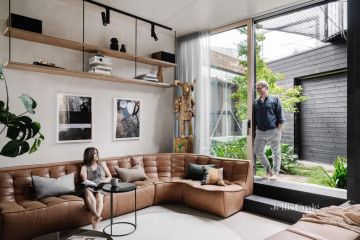Designers share their favourite interiors trends for winter 2018
The cold nights and dark mornings of winter are few people’s favourite time of year, but the changing of the seasons does provide a valid excuse to change your home’s interiors for comfort, style and warmth.
By reconsidering the placement, materials, textures and colours of your furniture and decor, it’s possible to change the atmosphere of your home and create that cosy feeling so often craved in the cooler seasons.
This year, designers are favouring deep, rich shades of blues, greens, purples and browns. Think olive, burnt orange, russet, aubergine, petrol blue, burgundy, tan, cognac and indigo, complemented with more neutral shades such as grey and navy.
These colours all naturally contrast well with the pastel and jewel shades that have been popular in recent years. Navy, mustards and neutrals, including taupe and grey, reflect the new season, according Amber Cooke, general manager of furniture for Domayne.
Full of Grace Interiors founder Therese Carrodus also expects to see more of the richest blue hue.
“I always think that navy never gets old either and always works so nicely as a moody backdrop to those warmer hues, so I suggest having fun by mixing them together,” she says.
Simply freshening up interior accessories such as towels, bed linen, cushions and throw rugs can create the illusion of a completely new space, and is a subtle way to inject new colours and materials into your home. After two years of velvet-heavy interiors, designers are now noticing a resurgence of felt that works particularly well on couch cushions, ottomans, storage baskets and rugs.
Another retro material making a comeback is rattan, as seen in several fashion lines this season.
- Related: Outdated decor trends and what to replace them with
- Related: How to update your home in under 24 hours
- Related: These are the essential items for a new home
“Rattan has had a major resurgence recently and I think this material, paired with timber and brass, gives such lovely texture and warmth to an interior, especially during the winter months,” Carrodus says.
Anna Carin Design principal designer Anna-Carin McNamara predicts sophisticated coloured glass bricks and hard-wearing brown granite are other materials likely to soon resurface in home interiors.
Introducing new colours and materials into a space, especially rich shades and textiles a little left of centre, can be a daunting experience if you don’t know where to begin.
Speaking to designers reveals a range of helpful starting points, such as working around a key ‘hero’ item (an armchair or couch) or choosing pieces specifically to suit your space’s floor plan (a simple tip that’s easily forgotten when your favourite furniture store announces a sale).
“If we are ‘concepting’ a living room, we assess the best floor plan that will address issues such as the view, conversation, television and, most importantly, comfort,” Hare + Klein Interior Design principal Meryl Hare says.
“Comfort is a big subject on its own, as it is not just how comfortable the client finds the sofas and chairs, but also the lighting, ambience and control of heating, cooling, space planning and natural light. Once we have a concept, the colours, textures, furniture and art fall into place.”
McNamara suggests first auditing the items you already own in order to develop a cohesive interior theme.
“Remove everything that is a ‘maybe’ or ‘kind of like’ or ‘perhaps’, then use [what remains] as a base. If nothing is left, start with a rug.
“A rug warms the room, softens it and defines the space,” she says.
Decus Interiors principal and managing director Alexandra Donohoe Church says artwork can also be a great place to start.
“Tease out several key colours, patterns and textures and use these as the point of departure.”
Once an overall scheme for a space is determined, allow time for this to develop and try not to be tempted by trends or the promise of a bargain (if it’s not what you’re really after) along the way.
“I think the common mistake that people make is rushing into styling a room straight away. I find the interior then often looks a lot like a showroom without any real personality of the individual,” Carrodus says.
“Not everything should be matching and not everything needs to be styled at once. I think the best considered interiors are the ones that have evolved over time and have a mixture of furniture and artwork that are both new and old.”
Other common mistakes designers see include all the furniture being pushed up against the walls, artwork hung at an incongruous height and insufficient lighting.
To finish, Cooke of Domayne says sideboards, buffets and coffee tables are key investments. “Some have storage and can be used to showcase decorator pieces including greenery, vases and candles, adding more ambience to the room,” she says.
Get the look:
Rich colour: Be inspired by dark shades found in nature such as olive, petrol blue, aubergine and russet.
Felt: The popularity of felt is a natural extension of the velvet revival. “I think we are going to see more velvet, as well as natural fibres with texture. There is also a re-emergence of felt as a furnishing fabric that may work better in cooler climates,” Hare says.
Bronze: Consider bronze the new metallic of choice. “Bronze has an understated elegance that its popular cousin, brass, doesn’t possess,” Donohoe Church says.
Glass bricks: Glass bricks today are a far cry from their ’80s equivalents. See the Poesia Glass range by Austral Bricks. “There’s endless possibilities with these to play with light and colours,” McNamara says.
Rattan: Rattan is making a comeback for its transparency and classic elegance.
We recommend
We thought you might like
States
Capital Cities
Capital Cities - Rentals
Popular Areas
Allhomes
More







